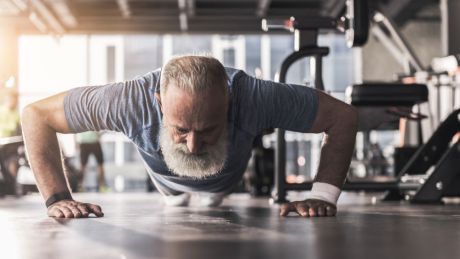The One Fitness Tip You Shouldn’t Ignore: Act Your Training Age
The time you’ve put in at the gym should affect how you should train. Here’s what you need to know

What’s my training age again?
“Your training age refers to the total training time you have in a form of training or sport, regardless of your actual chronological age,” says trainer Dan Forbes, founder of Veteran Athlete. “If you’ve been bodybuilding for six years, then you’d have a bodybuilding training age of six years regardless of whether you are 26 or 46.”
So it’s sport-specific?
Yep. Obviously, strength training and running build very different qualities, but there’s also some reason to consider different training styles in even narrower spheres. “For example, if you have been strength training for four years but have no experience in plyometrics, then your strength training age would be four years, but your plyometric training age would be zero,” says Forbes. “This would have implications when it came to adding a plyometric element to your training plan. And remember, training age is purely a measure of quantity, not quality. If volume of repetitions were indicative of ability, most boxercise class attendees would be world champions.”
OK, but how does it affect my training?
“Generally speaking, those with a low training age lack the co-ordination and skillset needed to be able to perform complex movements,” says Forbes. “But, as I mentioned, training age has no bearing on an individual’s level of expertise. I’m a big believer in ‘earning’ the right to progress to complexity. Spending time perfecting form, developing strength and building muscle size allows some time to develop the co-contractions [when multiple muscles contract simultaneously to provide stability] and muscle-firing patterns you need to perform more advanced options safely. That way you ensure you benefit from doing them regardless of your training age.”
So I shouldn’t be doing plyometrics if I’m new in the gym?
“This is a tough one,” says Forbes. “If you look at the ground reaction times and forces in sprints, it certainly qualifies as a plyometric, but very rarely do we ensure people can hit a decent squat before they start sprinting. Use common sense, and accept that there’s a hierarchy when it comes to strength/plyometric training, and you’ll be fine. I’ve seen someone who couldn’t trap bar deadlift half their bodyweight doing 1m depth jumps, and all they were doing was increasing their risk of injury while entirely missing the benefit of the exercise – it drove me insane.”
Not everyone needs to do advanced plyometrics, but for most people there are benefits to doing a few hops and jumps. “Skipping is a great example of a low-level plyometric that most people can throw into their programmes right now,” Forbes says.
What else should I be worried about?
The biggest thing is work capacity. If you haven’t spent a while building up the capacity and neural drive to tolerate doing six moves for each body part, you’d be better off picking one or two and hitting them as hard as you can. And some movements are unnecessarily complex for a new lifter: do you really need to do Olympic lifts when you could get 90% of their benefits from deadlifts and squats? Act your age and you’ll improve consistently with less risk of injury.
Get the Coach Newsletter
Sign up for workout ideas, training advice, reviews of the latest gear and more.
Coach is a health and fitness title. This byline is used for posting sponsored content, book extracts and the like. It is also used as a placeholder for articles published a long time ago when the original author is unclear. You can find out more about this publication and find the contact details of the editorial team on the About Us page.










